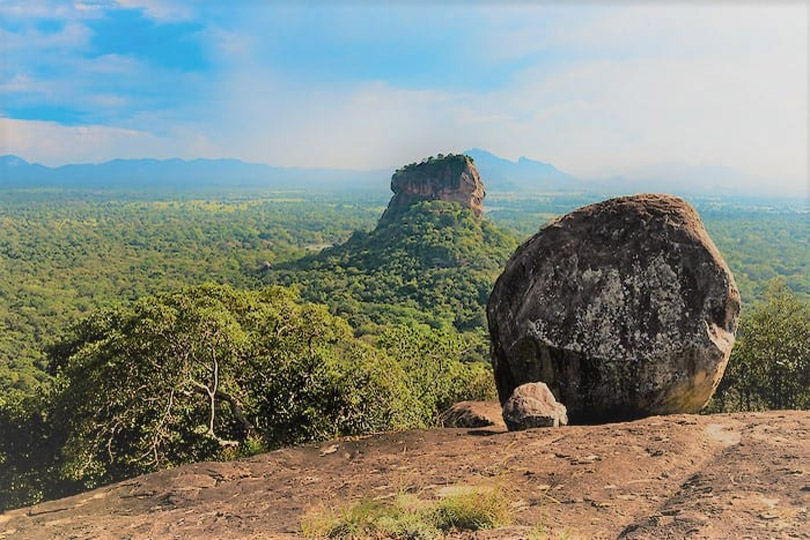
Pidurangala Rock
Towards the north-east of Sigiriya Rock is a famous hill of Pidurangala rising about one mile from the site. Pidurangala rock cave temple is also a part of many Sri Lanka tours that include Sigiriya and Dambulla caves. The rock temple abruptly rises up to 200 m from the surrounding area. An ancient cave dates back to Anuradhapura period, with an inscription written below the drip ledge, situated at the foot of the hill has been restored to a modern vihara. By this site, an ancient path of rough stepping stones leads up the hill where the overhanging rock on the eastern side shelters a very long cave.

History of Pidurangala rock cave temple
King Kashyapa who built Sigiriya also built Pidurangala rock cave temple. This monastery housed over 500 Buddhist monks and was completed with the five ritual sections: the chapter house, image house, a Bo-tree, a shrine and monks dwellings. In Pidurangala rock are meditation caves, paintings, and a statue of a reclining Buddha.
Pidurangala rock temple is one of the well known historical places on the island. A part of the Pidurangala rock temple is located at the base of the mountain and rest of the temple is built to close to the pinnacles. Built on this Pidurangala rock are a Buddhist monastery and a cave temple.
Image house of Piduranghala rock cave temple is built in a huge granite cave located at the ground level houses several Buddha statues in meditation, standing and reclining postures. The image house of Pidurangala rock cave temple is also dating back to the 5th century AD (as old as Sigiriya rock fortress). There is a number of paintings and statues at Pidurangala rock cave temple image house depicting various incidents of Buddha’s life.
Also at the summit, Pidurangala rock is the remnant of the shrine and the site at which young monks were taught. Remarkably, the Pidurangala rock has drip ledge to prevent rain from falling into the meditation caves. The rock edges are carved on to the outer surface of the opening and it is one of the oldest engineering works in the world. A Brahmi inscription on one of these drop edges the original temple back to the period of third century B.C.
The Sigiriya area has many such cave dwellings used by monks for meditation but it is believed that given Kashyapa’s patronage, Pidurangala rock temple had prominence as the spiritual centre for his court.
How do I go to Pidurangala rock cave temple?
Pidurangala rock cave temple is located towards the southern borders of Sigiriya rock fortress and near Sigiriya nature reserve. The narrow road that goes along the water ditch makes the way to Pidurangala rock cave temple. Today it is one of the major religious places in the area and attracts a large number of local devotees. A part of the historical Pidurangala rock cave temple is located on a mountain while the rest of it to be found at the ground level of the hill.
At the Pidurangala rock, there is a 14 meter long Buddha statue believed to be dating back to the 5th century AD. The Buddha statue is made of bricks shows fine craftsmanship of the historical artisans. Unfortunately, the part of the statue is destroyed by the relic hunters in the past. There is a big hole dug into the statue in the belly area of the reclining Buddha statue. The footpath between the dry zone forest vegetation leads to the summit. There are several caves on the rocky hill of Pidurangala and they had been using by the residential monks in the early days.

What do I see in Pidurangal rock cave temple?
Within the cave, numerous chambers built of small stones and clay plaster face the eastern direction. An inscription datable to the 7thcentury has been found on the rocky ground in front of cave 9 and records the grant of gold and paddy fields. It is still recognizable on the brick wall of this chamber painting of a female figure in green in much the same style as the paintings on the main rock of Sigiriya. The chamber 10 also built of brick and plastered white is the largest within the cave. Much of the plaster is lost from the walls of this main shrine room which contains along brick and stucco recumbent image of the Buddha.
Archaeologists are in different views as far as the beginning of the temple is a concern, as the archaeologist’s claim that the temple was built from 5th to 10th century. The two side walls of the shrine belong to a later period than the walls of the other chambers. On the outer face of these two walls are to be seen pilasters moulded in brick and plastered and recessed arches. Beyond the shrine, there are the remains of another chamber and two rock-cut ponds lie further ahead.
